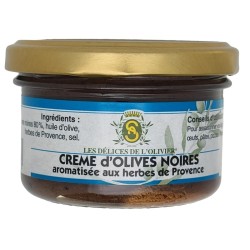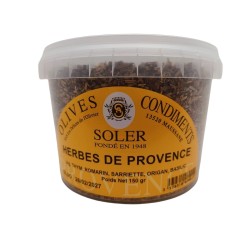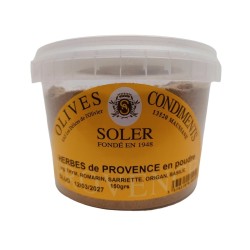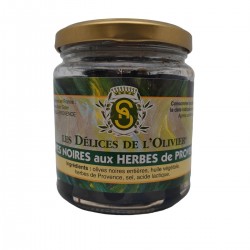
Herbs of Provence from Every Angle
Herbs of Provence from Every Angle
The hills of Provence hold within them an aromatic richness that transcends mere culinary aspects.
The herbs of Provence, an iconic selection of aromatic plants, embody the very essence of Provencal cuisine.
This in-depth exploration unveils them through multiple prisms, from their ancient history to their contemporary role in our kitchens.
More than just a dried blend, the term "herbs of Provence" evokes a symphony of Provencal flavors, resulting from the traditional gathering of plants such as thyme, savory, marjoram, oregano, rosemary, basil, chervil, tarragon, lovage, savory, sage, bay leaf, and fennel.
Over the decades, this blend has evolved from the wild state to organized production, a transition we will explore in detail.
This dive into the world of Provencal herbs goes beyond their history and gathering, extending to global trade, modern production, and their impact on our plates.
From Haute-Provence to processing plants, from negotiations to distribution, we examine every facet of these herbs that have conquered the world while preserving their Provencal authenticity.
Get ready to discover the herbs of Provence from every angle, from the secrets of their gathering to the art of incorporating them into modern dishes.
This aromatic odyssey will take you to the heart of Provence, where history, production, and cuisine merge to create an unforgettable sensory experience.
1. History of Herbs of Provence
The roots of "herbs of Provence" extend deep into the Provencal lands, where a variety of wild aromatic plants have long perfumed local cuisine.
This traditional selection includes thyme, savory, marjoram, oregano, rosemary, basil, chervil, tarragon, lovage, savory, sage, bay leaf, and fennel.
Originally, these herbs were wild-harvested, reflecting the authentic character of Provencal cuisine.
Over time, the term "herbs of Provence" evolved to encompass a dried blend of these plants, successfully created by a French agri-food company in the 1960s.
This expression, while not a protected designation, helped popularize these herbs beyond the borders of Provence.
Today, the "herbs of Provence" blend is produced in a more organized manner, representing half of the market.
However, only 10% of these dried herbs sold in France are locally produced.
Production mainly comes from Central and Eastern European countries, the Maghreb, and China, with Marseille companies playing a key role in trade and distribution.
2. Traditional Harvesting and Modern Production
Traditional harvesting of herbs of Provence has long been rooted in Provencal practices, where these aromatic plants were harvested in the wild.
Thyme, savory, marjoram, oregano, rosemary, basil, chervil, tarragon, lovage, savory, sage, bay leaf, and fennel were carefully selected from the hills and fields of the region.
However, market evolution has led to a transition to more organized production.
Initially, these herbs were exclusively gathered, but today, with increasing demand, they are also cultivated by the agri-food industry. This transformation has met market needs while preserving the characteristic quality of herbs of Provence.
Modern production is divided between family kitchen gardens, pots on balconies, and organized large-scale production.
Currently, about 10% of dried herbs of Provence sold in France are locally sourced.
The majority comes from countries such as Poland, Albania, the Maghreb, and China, where they are grown to meet global demand.
3. Trade and Distribution
The trade of herbs of Provence is part of a complex dynamic, where Marseille companies play a central role.
They supply packaging and distribution factories such as Ducros, Gyma, or Amora Maille from Dijon, thus contributing to the global presence of these emblematic herbs.
Two producer groups have formed in the Provence-Alpes-Côte d'Azur region, strengthening the supply of herbs of Provence.
Despite this, the entire regional harvest, mainly concentrated in Haute-Provence, is absorbed by processing plants.
These plants then market the herbs, whether dried or vacuum-packed.
Figures reveal an intriguing reality: only 10% of dried herbs of Provence sold in France are currently produced in the country. The vast majority
4. Label Rouge: Quality at the Forefront
The quest for quality led to the creation of the Label Rouge for herbs of Provence, issued by the National Institute of Origin and Quality (INAO). This label is a guarantee of excellence, ensuring a specific recipe for discerning enthusiasts.
The composition of the Label Rouge blend is rigorously defined, including 27% rosemary, 27% oregano, 27% savory, and 19% thyme.
Each of these ingredients uniquely contributes to the characteristic aroma and flavor of herbs of Provence Label Rouge.
This label represents not only a tribute to Provencal tradition but also a commitment to quality and authenticity.
Herbs of Provence bearing the Label Rouge are the result of meticulous production and meet the strict standards set by the INAO.
By opting for these herbs, consumers choose excellence and participate in preserving the aromatic richness of Provence.
5. Varied Culinary Use
Herbs of Provence, with their unique blend, enrich a multitude of dishes, offering a diversity of flavors that transcend culinary boundaries.
Their varied use in cooking extends from grilling to sauces, stews to roasts, fish to marinades, pasta to tomato-based dishes, and beyond.
These aromatic herbs bring a Provencal note to every bite, transforming simple dishes into exceptional culinary experiences.
Their complex aromas, stemming from the harmonious marriage of thyme, rosemary, savory, oregano, and other plants, add a depth of flavor that tantalizes the taste buds.
Whether in everyday cooking or for special occasions, herbs of Provence offer unparalleled culinary versatility.
Their fragrant presence in traditional Provencal cuisine now extends to contemporary creations, captivating chefs and food enthusiasts worldwide.
Conclusion
Herbs of Provence, the fragrant heritage of Provencal lands, transcend culinary boundaries to become a complete sensory experience.
From their traditional harvesting to modern production, from international trade to varied culinary use, these emblematic herbs continue to delight palates worldwide.
May every bite be an ode to the aromatic richness of Provence, a symphony of flavors that endures through time.




